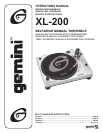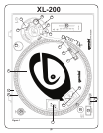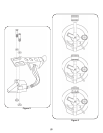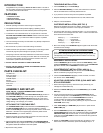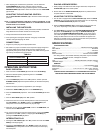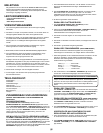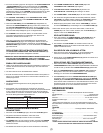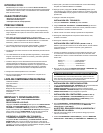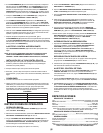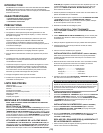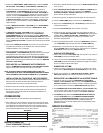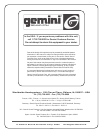
(4)
INTRODUCTION:
Congratulations on purchasing a Gemini XL-200 turntable. This state of
the art turntable includes the latest features. Prior to use, we suggest that
you carefully read all the instructions.
FEATURES
• ±10% Pitch control:
• Strobe illuminator
• Soft-touch start/stop switch
PRECAUTIONS:
1. Read all operating instructions before using this equipment.
2. The apparatus should not be exposed to dripping or splashing, and no
objects filled with liquids such as vases should be placed on the apparatus.
3. To reduce the risk of electrical shock, do not open the unit. There are
NO USER REPLACEABLE PARTS INSIDE. Please contact the Gemini
Service Department or your authorized dealer to speak to a qualified
service technician.
4. Tone Arm bearings are factory set and sealed. Any attempt at adjustment
will void the warranty.
5. Be sure that all AC power is OFF while making connections.
6. Cables should be low capacitance, shielded and of proper length. Make
sure that all plugs and jacks are tight and properly connected.
7. Always begin with the audio level faders/volume controls set at minimum
and the speaker volume control(s) set to OFF. Wait 8 to 10 seconds prior
to turning up the speaker volume to prevent the transient “POP” that
could result in speaker/crossover damage.
8. DO NOT EXPOSE THIS UNIT TO RAIN OR MOISTURE.
9. DO NOT USE ANY SPRAY CLEANER OR LUBRICANT ON ANY
CONTROLS OR SWITCHES.
PARTS CHECKLIST:
Turntable unit...............................................................................................1
Dust cover hinge..........................................................................................2
Turntable platter...........................................................................................1
45 RPM adapter...........................................................................................1
Slipmat.........................................................................................................1
Counter balance..........................................................................................1
Dust cover....................................................................................................1
Headshell.....................................................................................................1
ASSEMBLY AND SET-UP:
NOTE: SEE FIG. 1 FOR PART NUMBERS AND LOCATIONS.
VOLTAGE SELECTION:
Rotate the PLATTER (2) until the VOLTAGE SELECTOR (3) (located on
the TURNTABLE BASE (1)) is visible through one of the platter holes.
Make sure that the VOLTAGE SELECTOR switch is set to the correct
voltage. WARNING: If you try to operate the turntable with the incorrect
voltage setting, it can damage your turntable.
ATTACHING THE TURNTABLE BELT:
The TURNTABLE BELT (4A) comes attached to the PLATTER (2) and
the MOTOR SPINDLE (4B) but can some times detach in shipping.
Rotate the PLATTER (2) and look through the platter holes to check if belt
detached. If the belt is not wrapped tightly around the platter and the
MOTOR SPINDLE, you need to reattach it.
1. Remove the platter and wrap the belt around the inner circle under the
platter. DO NOT STRETCH OUT THE BELT.
2. Replace the platter and rotate the PLATTER (2) until the MOTOR SPINDLE
(4B) is visible, then fit your fingers in hole on the top of the PLATTER (2), feel for
and grab the rubber belt and attach to the motor spindle.
3. Replace the locking washer.
TURNTABLE INSTALLATION:
1. Put the SLIPMAT (5) on the PLATTER (2).
2. Set the TURNTABLE BASE (1) on a flat, level surface free of vibration.
Use the turntable feet to horizontally stabilize the unit.
3. Try to place the unit as far away from the speakers as possible.
4. Keep the unit away from direct exposure to the sun, heat, moisture or dirt.
5. Keep the unit well ventilated.
CARTRIDGE INSTALLATION: (SEE FIG. 2)
Because all cartridges have their own designs, please refer to your
particular cartridge’s instructions to insure proper installation.
1. Connect the lead wires to the cartridge terminals. For your convenience,
the terminals of most cartridges are color coded. Connect each lead wire
to the terminal of the same color.
White (L+).................Left Channel +
Blue (L-)...................Left Channel -
Red (R+)....................Right Channel +
Green (R-).................Right Channel -
2. Mount the cartridge in the HEADSHELL (6) and tighten it with the screws
included with the cartridge.
ATTENTION STANTON 680 CARTRIDGE USERS
When using a Stanton 680 or similar cartridge, where the body is
grounded to a cartridge terminal, remove the grounding strap from the
cartridge body to the cartridge ground terminal. Failure to do this may
result in excessive hum.
HEADSHELL INSTALLATION:
Insert the HEADSHELL (6) into the front of the tubular TONE ARM (7). While
holding the HEADSHELL firmly in a horizontal position, turn the LOCKING NUT
(8) counter clockwise until the HEADSHELL is locked in place.
COUNTERWEIGHT INSTALLATION: (SEE FIG. 3)
1. Slide the COUNTERWEIGHT (9) onto the rear of the TONE ARM (7)
with the numbered stylus gauge facing forward.
2. Twist the COUNTERWEIGHT (9) lightly counter clockwise, to screw it
onto the rear of the TONE ARM (7) .
ADJUSTING HORIZONTAL ZERO (0) BALANCE AND
STYLUS PRESSURE:
1. Without touching the stylus tip, remove the stylus protector (if your
cartridge has a detachable one).
2. Release the ARM CLAMP (10) and lift the TONE ARM (7) off the ARM
REST (11).
3. Counter clockwise advancement of the COUNTERWEIGHT (9) will
cause the cartridge side of the TONE ARM (7) to be lowered. Clockwise
will cause the opposite. Turn the COUNTERWEIGHT clockwise or
counter clockwise as needed until the TONE ARM is balanced
horizontally. You can easily tell this by watching for the point where the
TONE ARM “floats” freely.
4. Place TONE ARM (7) on ARM REST (11) and lock it in place with the
ARM CLAMP (10).
5. With the TONE ARM (7) locked on the ARM REST (11), hold the
COUNTERWEIGHT (9) steady with one hand while rotating the STYLUS
PRESSURE RING (12) until the numeral “0” on the ring aligns with the
center line on the TONE ARM rear shaft. The horizontal zero (0) balance
should be completed.
6. Refloat the TONE ARM to ensure horizontal zero (0) balance. If zero
balance has not been maintained, repeat counterweight steps 3 - 5.



